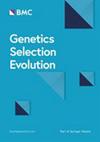Metabolomic-genomic prediction realizes small increases in accuracy of estimated breeding values for daily gain in pigs
IF 3.1
1区 农林科学
Q1 AGRICULTURE, DAIRY & ANIMAL SCIENCE
引用次数: 0
Abstract
Metabolomic profiling of blood samples can be done on selection candidates and could be a valuable information source for genetic evaluation of pigs. We hypothesized that integrating metabolomic data from pigs without individual phenotypes into the metabolomic-genomic best linear unbiased prediction (MGBLUP) model would generate estimated breeding values (EBVs) with a higher accuracy compared to what would be obtained without metabolomic data. We tested this hypothesis by predicting breeding values for average daily gain (ADG) using phenotypic, genomic, and metabolomic data. MGBLUP models were fitted to average daily gain of 8174 Duroc pigs that were genotyped and profiled for metabolomic features. Approximately half the pigs were males from a test station and the other half were females from breeding herds. Variance components were estimated, and we employed two validation schemes: test station to breeding herd validation and fivefold cross-validation. Accuracies of EBVs in the validation population were computed by combining results on predictive abilities with results on increases in accuracies from the linear regression method. Parameter estimates from MGBLUP showed a direct heritability of ADG of 0.15, a proportion of variance explained by metabolomic features of 0.18, and a heritability of metabolomic intensities of 0.14, together resulting in a total heritability of 0.17. Thus, the majority of the heritability was not mediated by the metabolome. For the test station to breeding herd validation, the accuracies of EBVs were 0.60 for genomic best linear unbiased prediction (GBLUP) with genotypes in validation population, 0.61 for MGBLUP with genotypes in validation population, 0.62 for MGBLUP with genotypes and metabolomic features in validation population, 0.72 for GBLUP with genotypes and phenotypes in validation population, and 0.74 for MGBLUP with genotypes, phenotypes and metabolomic features in validation population, whereas the corresponding numbers were 0.87, 0.87, 0.87, 0.91 and 0.92 for the fivefold cross-validation. Therefore, small increases in accuracies were observed when including metabolomic features. The inclusion of metabolomics data provided small improvements in the accuracy of genetic evaluations for average daily gain in pigs. Further work will be needed to investigate, e.g., alternative time points for blood sampling, metabolomics on samples of other tissues, and other traits.代谢组学-基因组预测实现了猪日增重估计育种值准确性的小幅提高
血液样本的代谢组学分析可以在选择候选者上完成,并且可以作为猪遗传评估的有价值的信息来源。我们假设,将没有个体表型的猪的代谢组学数据整合到代谢组学-基因组最佳线性无偏预测(MGBLUP)模型中,与没有代谢组学数据的模型相比,可以获得更高精度的估计育种值(ebv)。我们通过使用表型、基因组和代谢组学数据预测平均日增重(ADG)的育种值来验证这一假设。MGBLUP模型拟合8174头杜洛克猪的平均日增重,对这些猪进行基因分型和代谢组学特征分析。大约一半的猪是来自试验站的雄性,另一半是来自种猪群的雌性。对方差成分进行了估计,并采用了两种验证方案:试验站对种畜的验证和五重交叉验证。验证人群中ebv的准确性通过将预测能力的结果与线性回归方法准确性增加的结果相结合来计算。MGBLUP的参数估计表明,ADG的直接遗传率为0.15,代谢组学特征解释的方差比例为0.18,代谢组学强度的遗传率为0.14,总遗传率为0.17。因此,大部分遗传力不是由代谢组介导的。对于试验站到种猪群验证,验证群体中基因型的基因组最佳线性无偏预测(GBLUP) ebv的准确性为0.60,验证群体中基因型的MGBLUP为0.61,验证群体中基因型和代谢组特征的MGBLUP为0.62,验证群体中基因型和表型的GBLUP为0.72,验证群体中基因型和表型的MGBLUP为0.74。五重交叉验证的结果分别为0.87、0.87、0.87、0.91和0.92。因此,当包括代谢组学特征时,观察到准确性的小幅增加。代谢组学数据的纳入在猪平均日增重遗传评估的准确性方面提供了微小的改进。进一步的工作将需要调查,例如,血液采样的替代时间点,其他组织样本的代谢组学和其他特征。
本文章由计算机程序翻译,如有差异,请以英文原文为准。
求助全文
约1分钟内获得全文
求助全文
来源期刊

Genetics Selection Evolution
生物-奶制品与动物科学
CiteScore
6.50
自引率
9.80%
发文量
74
审稿时长
1 months
期刊介绍:
Genetics Selection Evolution invites basic, applied and methodological content that will aid the current understanding and the utilization of genetic variability in domestic animal species. Although the focus is on domestic animal species, research on other species is invited if it contributes to the understanding of the use of genetic variability in domestic animals. Genetics Selection Evolution publishes results from all levels of study, from the gene to the quantitative trait, from the individual to the population, the breed or the species. Contributions concerning both the biological approach, from molecular genetics to quantitative genetics, as well as the mathematical approach, from population genetics to statistics, are welcome. Specific areas of interest include but are not limited to: gene and QTL identification, mapping and characterization, analysis of new phenotypes, high-throughput SNP data analysis, functional genomics, cytogenetics, genetic diversity of populations and breeds, genetic evaluation, applied and experimental selection, genomic selection, selection efficiency, and statistical methodology for the genetic analysis of phenotypes with quantitative and mixed inheritance.
 求助内容:
求助内容: 应助结果提醒方式:
应助结果提醒方式:


